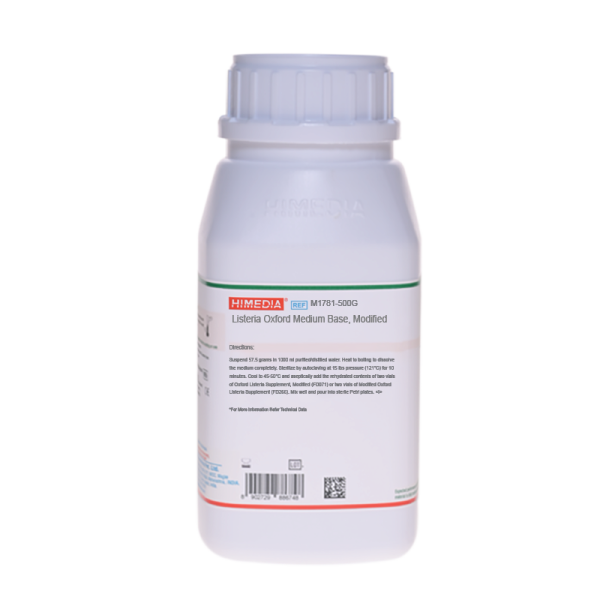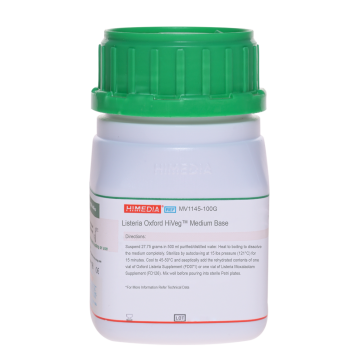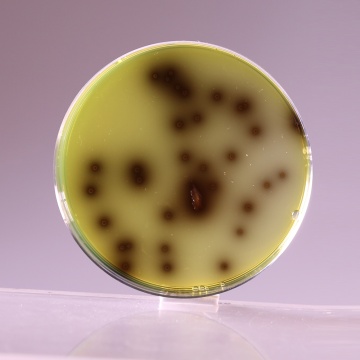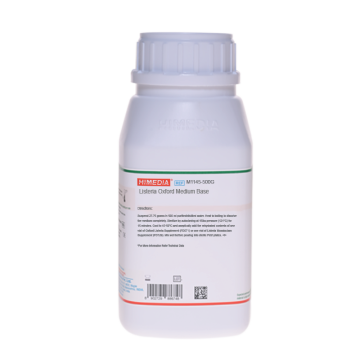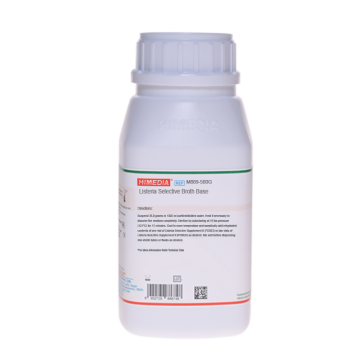 Your enquiry has been submitted
Your enquiry has been submitted
Listeria Oxford Medium Base, Modified
Intended Use
Recommended for isolation and differentiation of Listeria species from clinical specimens.
Composition**
| Ingredients | g / L |
|---|---|
| Tryptone | 8.900 |
| HMH extract B# | 2.700 |
| Proteose Peptone, B | 4.400 |
| Yeast Extract | 4.400 |
| Lithium Chloride | 15.000 |
| Sodium Chloride | 4.400 |
| Corn Starch | 0.900 |
| Esculin | 1.000 |
| Ammonium Ferric Citrate | 0.500 |
| Agar | 15.300 |
| Final pH ( at 25°C) | 7.2±0.2 |
**Formula adjusted, standardized to suit performance parameters
# Equivalent - Beef heart extract
Directions
Suspend 57.5 grams in 1000 ml purified / distilled water. Heat to boiling to dissolve the medium completely. Sterilize by autoclaving at 15 lbs pressure (121°C) for 10 minutes. Cool to 45-50°C and aseptically add the rehydrated contents of 2 vials of Oxford Listeria Supplement (FD071) or 2 vials of Listeria Moxalactam Supplement Modified (FD266). Mix well and pour into sterile Petri plates.
Principle And Interpretation
Listeria monocytogenes is the only species of the genus Listeria that is important as a human pathogen. Listeria seeligeri, Listeria welshimeri and Listeria ivanovii have been related with animal diseases. In any case, all the species are pathogenic between the ovine and bovine cattle. Positive diagnosis of listeriosis can be obtained only by the isolation and cultivation of the responsible bacteria from blood or CSF samples of the affected organisms. Listeria Oxford Medium Base is based on the formulation described by Curtis et al (2) for isolation of L. monocytogenes from clinical and food specimens.
Tryptone, HMH extract B, proteose peptone B and yeast extract serves as the source of carbon, nitrogen compounds, long chain amino acids, vitamins and other essential nutrients to the organisms. Corn starch serves to neutralize the toxic metabolites formed. Lithium chloride and the antibiotics inhibit gram-negative bacteria and most gram-positive organisms but certain strains of Staphylococci may grow as esculin negative colonies. Cycloheximide is used to reduce fungal contamination; cefotetan and fosfomycin are inhibitors of bacterial overgrowth. Acriflavin, colistin sulphate and lithium chloride inhibit bacteria other than Listeria species. Alternatively moxalactam (FD266) can be added which inhibits both gram-positive and gram-negative bacteria.
L. monocytogenes hydrolyzes esculin to esculetin and dextrose. Esculetin reacts with ferric ions and produces black zones around the colonies. Although the selectivity of the medium is enough to allow the isolation and differentiation by direct surface inoculation, a previous dilution of the inoculum is advisable or even more when the sample is highly polluted. The techniques for isolation vary with the material under examination (8). For all specimens selective and cold enrichment is recommended (3, 4). For faecal and biological specimens, the sample is homogenized in 0.1% Peptone Water (M028) and 0.1 ml amount is either directly plated on Listeria Selective Medium or inoculated into the Selective Enrichment Broth and incubated at 30°C for 7 days and then further inoculated on Listeria Selective Medium. For food and environmental samples selective enrichment is generally used.
For isolation of Listeria from food (milk and milk products), add 25 ml or 25 grams of sample to 225 ml of Listeria Enrichment Broth, UVM (M890A). Homogenize and mix carefully. Incubate for 48 hours at 30°C. Streak the enriched cultures onto Listeria Oxford medium Base and incubate aerobically for 48 hours at 37°C. Take 5 typical colonies (esculin positive) and inoculate onto Soyabean Casein Digest Medium (M290). Incubate for 24 hours and then use these colonies for biochemical confirmation.
Type of specimen
Clinical samples - vaginal swab; Food and dairy samples.
Specimen Collection and Handling
For clinical samples follow appropriate techniques for handling specimens as per established guidelines (5,6). For food and dairy samples, follow appropriate techniques for sample collection and processing as per guidelines (1,7,9). After use, contaminated materials must be sterilized by autoclaving before discarding.
Warning and Precautions
In Vitro diagnostic Use only. For professional use only. Read the label before opening the container. Wear protective gloves/protective clothing/eye protection/ face protection. Follow good microbiological lab practices while handling specimens and culture. Standard precautions as per established guidelines should be followed while handling clinical specimens. Safety guidelines may be referred in individual safety data sheets.
Limitations
- Further biochemical and serological tests must be carried out for complete identification.
- Destitute and a weak esculin reaction may be seen after 40 hours incubation for some enterococci.
Performance and Evaluation
Performance of the medium is expected when used as per the direction on the label within the expiry period when stored at recommended temperature.
Quality Control
Appearance
Light yellow to dark yellow homogeneous free flowing powder
Gelling
Firm, comparable with 1.0% Agar gel.
Colour and Clarity of prepared medium
Dark amber coloured clear to slightly opalescent gel with a blue cast forms in Petri plates
Reaction
Reaction of 5.55% w/v aqueous solution at 25°C. pH : 7.2±0.2
pH
7.00-7.40
Cultural Response
Cultural characteristics observed with added Oxford Listeria Supplement (FD071) or Listeria Moxalactam supplement Modified (FD266), after an incubation at 35-37°C for 24-48 hours.
| Organism | Inoculum (CFU) | Growth | Recovery | Esculin Hydrolysis |
|---|---|---|---|---|
| # Bacillus subtilis subsp. spizizenii ATCC 6633 (00003*) | >=10⁴ | inhibited | 0% | |
| Enterococcus faecalis ATCC 29212 (00087*) | >=10⁴ | inhibited | 0% | |
| Enterococcus hirae ATCC 10541 | >=10⁴ | inhibited | 0% | |
| Escherichia coli ATCC 25922 (00013*) | >=10⁴ | inhibited | 0% | |
| Listeria monocytogenes ATCC 19111 (00020*) | 50-100 | luxuriant | >=50% | positive reaction, blackening of medium around the colony |
| Listeria monocytogenes ATCC 19112 | 50-100 | luxuriant | >=50% | positive reaction, blackening of medium around the colony |
| Listeria monocytogenes ATCC 19117 | 50-100 | luxuriant | >=50% | positive reaction, blackening of medium around the colony |
| Staphylococcus aureus subsp. aureus ATCC 25923 (00034*) | 50-100 | good | 40-50% | negative reaction |
Key : * - Corresponding WDCM numbers.
# - Formerly known as Bacillus subtilis subsp. spizizenii
Storage and Shelf Life
Store between 10-30°C in a tightly closed container and the prepared medium at 2-8°C. Use before expiry date on the label. On opening, product should be properly stored dry, after tightly capping the bottle in order to prevent lump formation due to the hygroscopic nature of the product. Improper storage of the product may lead to lump formation. Store in dry ventilated area protected from extremes of temperature and sources of ignition Seal the container tightly after use. Product performance is best if used within stated expiry period.
Disposal
User must ensure safe disposal by autoclaving and/or incineration of used or unusable preparations of this product. Follow established laboratory procedures in disposing of infectious materials and material that comes into contact with clinical sample must be decontaminated and disposed of in accordance with current laboratory techniques (5,6).
Reference
- American Public Health Association, Standard Methods for the Examination of Dairy Products, 1978, 14th Ed., Washington D.C.
- Curtis G. D. W., Mitchell R. G, King A. F., Griffin E. J., 1989,Lett. Appl. Microbiol.,8:95
- Fernandez G. J. F., Dominguez R. L., Vazzuez B. J. A., Rodriguez F.E. F., Briones D. V., Blanco L. J. L., Suarez F. G., 1986, Can. J. Microbiol., 32:149.
- Hayes P. S, Feeley J. L, Groves L. M, Ajello G. W. and Fleming D. W, 1986, Appl. Environ. Microbiol., 51:438.
- Isenberg, H.D. Clinical Microbiology Procedures Handbook 2nd Edition.
- Jorgensen, J.H., Pfaller, M.A., Carroll, K.C., Funke, G., Landry, M.L., Richter, S.S and Warnock., D.W. (2015) Manual of Clinical Microbiology, 11th Edition. Vol. 1.
- Salfinger Y., and Tortorello M.L. Fifth (Ed.), 2015, Compendium of Methods for the Microbiological Examination of Foods, 5th Ed., American Public Health Association, Washington, D.C.
- Van Netten P., Peroles I., Van de Mosdik A., Curtis G. D. W., Mossel D. A. A, 1988, Int. J. Food Microbiol., 6:187.
- Wehr H. M. and Frank J. H., 2004, Standard Methods for the Microbiological Examination of Dairy Products, 17th Ed., APHA Inc., Washington, D.C.
| Product Name | Listeria Oxford Medium Base, Modified |
|---|---|
| SKU | M1781 |
| Product Type | Regular |
| Physical Form | Powder |
| Origin | Animal |
| Packaging type | HDPE |
| References | 1. Curtis G. D. W., Mitchell R. G, King A. F., Griffin E. J., 1989,Lett. Appl. Microbiol.,8:95 |
| Customized Product Available | No |



